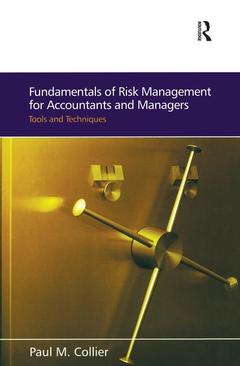Description
Fundamentals of Risk Management for Accountants and Managers
Tools & Techniques
Author: Collier Paul M.
Language: English
Subject for Fundamentals of Risk Management for Accountants and Managers:
Keywords
enterprise; appetite; internal; audit; control; committee; corporate; governance; function; process; Anti-virus Software; Enterprise Risk Management; Deloitte Touche Tohmatsu; Uncertainty Avoidance; Business Processes; IFAC; ERM Framework; Internal Audit Function; Short Term Interest Rate Futures; COSO’s Enterprise Risk Management; Organization’s Risk Appetite; Audit Committee; Risk Appetite; Internal Auditors; Enterprise Wide Risk Management; Operational Risk Management Framework; Operational Risk Management; UK Company Law; UK Government Bond; UK Data Protection Act; UK Company Act; Financial Reporting Council; UK Financial Service Authority; Turnbull Guidance; Freddie Mac
Publication date: 04-2016
· 15.6x23.4 cm · Hardback
Approximative price 52.85 €
Subject to availability at the publisher.
Add to cartPublication date: 03-2009
285 p. · Paperback
Description
/li>Contents
/li>Readership
/li>Biography
/li>Comment
/li>
Both financial and non-financial managers with accountability for performance at either a strategic level or for a business unit have responsibility for risk management, in terms of failing to achieve organisational objectives.
Fundamentals of Enterprise Risk management is structured around four parts and 26 self-contained chapters. Each chapter will have ample practical examples and illustrations/mini-case studies from retail, manufacturing and service industries and from the public and not-for-profit sectors to enable the reader to understand and apply the concepts in the book.
Part A: Introducing risk management
1.The emergence of risk
The origins of the risk discipline in OH&S, insurance, project management and financial derivatives. Influence of key writers such as Beck and Adams.
2.The corporate governance agenda
The influence of Cadbury, corporate failures at Enron and WorldCom, Sarbanes-Oxley, the King Report, audit and risk committees.
3.Corporate governance and risk management in the public and not-for-profit sectors
Part B: A strategic perspective on Enterprise Risk Management
4.Towards Enterprise Risk Management (ERM)
The traditional approach to risk management compared with ERM. Various models of risk management, e.g. COSO (US), the IRM (UK), the Australian risk standard, Basel, etc.
5.Risk and strategy: product/markets, supply chain, competitive position, brands, regulation, technology change, reputation, distribution channels. Risk and sustainable competitive advantage.
6.Risk categorisation
Types of risk and the advantages of categorisation
7.Techniques for identifying and assessing risks
Likelihood/consequences. Risk registers. Risk reviews.
8.The manager's role in risk management
Role of the risk manager. Risk management groups. Risk management software. Risk management policy
9.Risk and culture
Risk appetite. National, organisational and professional cultures. Embedding risk into the organisation.
Part C: Risk applications in the organisation
10.Risk and financial reporting
Reporting to shareholders, divisional performance measurement
11.Risk and financial decision making
Budgeting, profitability analysis, capital investment
12.Risk and information systems
Systems design, development and implementation. The IT environment and different applications. Networks. IT controls
13.Risk in financial services
Derivatives, Interest rates, Foreign exchange
14.Health and safety risk management
Risk assessments. Risk auditing. Risk recording
15.Credit risk management
Credit approval. Credit management. Credit financing.
16.Asset risk management
Supply chain risks. Purchasing risk. Breakdown risk. Obsolescence risk.
17.Project risk management and contract risk
Legal and commercial risk. Negotiating and managing contracts and projects. Technical and contractual delivery.
18.Risk and fraud
Preventing, identifying and responding to fraud
19.Risk and the environment
Pollution, contamination, sustainability and global warming. ISO14000
20.Risk and crisis management
From 9/11 to business continuity
21.Risk and insurance
Principles of insurance. Liability. Property. Self insurance. Reinsurance.
Part D: Evaluating risk management
22.Risk, the audit committee and the risk committee
23.Risk and internal control
24.Risk and internal audit
25.Auditing risk management
26.The future of risk management
Glossary of terms
Index




